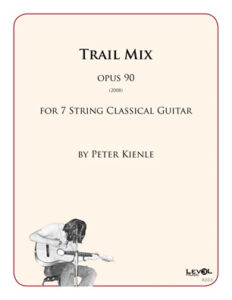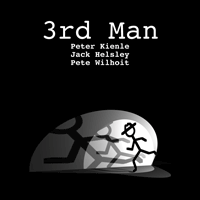Archive for the ‘Guitar Music’ Category
Evening Piece
This is a compact little piece recorded on a recent gigless Saturday evening. Not as restless anymore like I used to be.
Bach for 8 string guitar
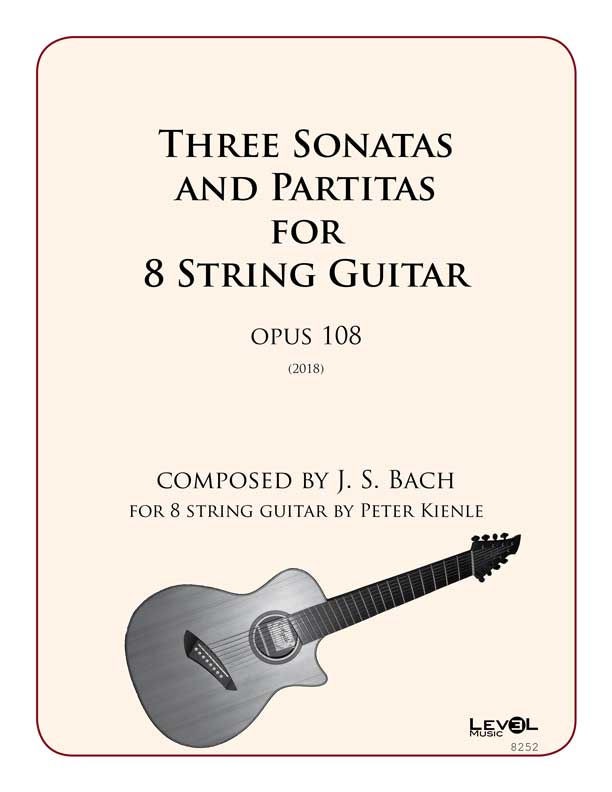
After fiddling with seven string guitars for a decade now, I found that it had not only expanded my horizon as a guitar player, but even more so infused new ideas and inspiration into my composing (not to mention the thourough exploration of rarely used keys). So, a few years ago, I thought maybe upgrading to eight strings might have the same effect. In a way it did – but more so because most of the time my musical brain just had no clue what notes were under my fingers on the 7th and 8th strings. Like a beginner I had to calculate rather the know what note was on a given position.
On the seven string guitar I had run into the same problem, compounded by the fact that existing guitar literature doesn’t offer much for extended range instruments. On the seven string I eventually adapted some Bach piano music to challenge myself to learn what that extra 7th string can do. For the eight string guitar I am working on new adaptations. This version of Bach’s Three Sonatas and Partitas is originally for the violin. It turned out that transposing it down an octave and writing it in bass clef would lead to a good low range workout on the eighth string. I admit that some of the lower chord voicings can be a challenge. They are harder to finger because of the longer scale and therefore wider fret spacing.
After I started playing through the whole set of pieces to check for accuracy I thought it might be a good idea to transpose some of them as low as possible. This would put them into new, unfamiliar keys and add even more challenges. For an added side effect the open strings in the lower keys come in handy in some spots.
These are for a guitar with added B and F# strings, although, if you tune your extra strings to A and E it could also work. You can use a pick or your fingers or any hybrid approach you like. Unlike in the transcriptions from Bach’s piano music, I didn’t use any fingerings or TAB. The main purpose for me on this project is to challenge my sight reading. While my brain knows fairly well that the shell voicings (for example) replicate on the lowest strings, it still takes me an extra split second (and sometimes much longer) to intellectually grasp what note or chord I am playing.
Thank you J. S. Bach for such gorgeous music.
Three Sonatas and Partitas for 8 string guitar is a free 178 page PDF.
5000 Miles of Dirt
Recently I released the full version of Trail Mix, a suite of original pieces for seven string classical guitar. The fourth movement was the first piece I wrote specifically on and for the seven string. It’s a nice, melodic piece of music that developed itself out of the two opening chords. 5000 Miles of Dirt is the title of that movement which was inspired by a walk in the woods behind my mother-in-law’s house in Germany, on a short trip to Europe in 2007. It was November, no snow yet, relatively warm. I had walked my old, well-explored trails from when I still lived in Germany. But I took one wrong turn and then got lost. This was late afternoon and the sun sets early in the Swabian Alps in late Fall. After losing myself deeper and deeper I encountered a power line and decided I should follow it back to civilization. It was a successful strategy, except that power lines don’t usually follow a road or trail and this one mostly went straight across muddy fields. I eventually found my way back to the house – two hours late and with very dirty boots.
Surprisingly, I was able to find the mediocre recording I made of the fourth movement years ago. Often my classical guitar skills are lagging just a bit behind the music I compose. This commercial release contains numerous corrections, much more practical page turns, and two versions of each piece: one in just standard notation the second one standard notation with added tablature. While I am not a proponent for tablature per se, I think it makes sense to record fingerings that way.
Choros?
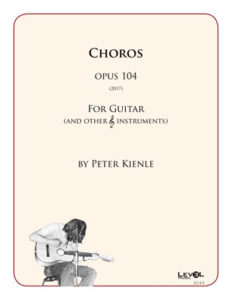 Wikipedia says (among other things) this about Choros:
Wikipedia says (among other things) this about Choros:
“Choro is an instrumental Brazilian popular music genre which originated in 19th century Rio de Janeiro. Despite its name, the music often has a fast and happy rhythm. It is characterized by virtuosity, improvisation and subtle modulations, and is full of syncopation and counterpoint.”
Another description I found:
“It is a complex popular musical form based on improvisation, and like New Orleans jazz, blues, or ragtime, grew from a formalized musical structure and many worldly influences.”
Many Choros to me actually do sound a little like ragtimes. But I am by no means whatsoever a Choro expert. I just always liked to play brazilian music on guitar and writing a Choro seemed a step up from a bossa or a samba. In that sense the pieces here are more like classical music rather than jazz tunes to be soloed over.
The first of these Choros was “Choro el Ninja” and it popped out in 2005. In many ways it is one of my favorites of the bunch which is why it was recorded on my CD Peter’s Money in 2009. While I was composing more music than ever before since then, every few months a new Choro arrived. Usually just a small melodic idea, which got expanded, transposed, taken to relative major or minor – one could say a lot of hot air.
Once I had a few of these and tried to actually play them I realized that this was excellent practice material – for sight-reading and fingering. Some of these I arranged for solo classical guitar but they are really hard to play and might get some thinning out when I have the chance. These 19 Choros represent a certain time period in my writing. I have since then tried to write more in that style but nothing presentable came out of it.
Choros is now available here. It contains all 19 Choros in standard notation and TAB.
A word about the titles:
I don’t speak Portuguese (I sometimes look up translations of English titles into Portuguese and use these if they sound interesting). Most of the titles reflect more me playing around with words, than expressing any important insights. Although, some of the Choros are named like pizzas on the menu of a pizzeria in Germany (..al Forno, Picante, Margarita, etc.)
Music Without Space
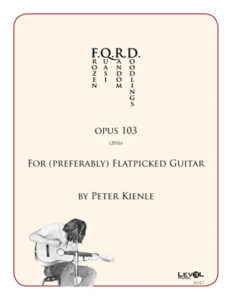 ….or something like that. This week I finished a collection of the strangest music I have ever written. Tentatively called Frozen Quasi Random Doodlings or FQRD.
….or something like that. This week I finished a collection of the strangest music I have ever written. Tentatively called Frozen Quasi Random Doodlings or FQRD.
From my earliest days as a guitarist I have been a fan of acoustic guitars and John McLaughlin. When he released the first string of Indian influenced acoustic LPs with Shakti in the 1970’s, it immediately spoke to me. With my rather limited technique I tried to improvise in that style. Over the years I collected various transcriptions of Shakti material, some done by friends some by myself. Obviously I was never able to play these along with the records, but they made excellent practice. These pieces have always been part of my practice schedule.
Fast forward to Summer of 2015, when my wife dragged the family to a conference of improvised music in Switzerland. This was not improvised music as in Jazz, but improvising with a bunch of people with little or no agreed upon parameters. Often more rewarding for the players than the listeners. One of the evening concerts was by a trio which included Swiss guitarist Christy Doran. This guy had been an early influence on me before even John McLaughlin – and I had all but forgotten. After returning to the US, I checked out his music on the web. While their set at the conference didn’t resonate as much with me, Christy’s own contemporary recordings really impressed me and I could easily see the connection to the band I originally heard him with in the 1970s, OM.
Science Fiction music was a thing even in 1977
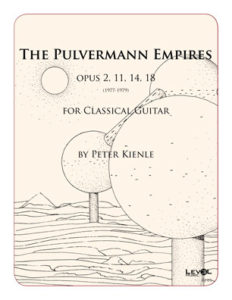 I freely admit that many, if not most, of my earlier writings for classical guitar are simplistic, juvenile and banal. On the other hand one has to start somehow somewhere, and I am glad that I held on to all of this material and didn’t put it in the garbage disposal of creative outbursts. As of this writing (February 2017) the first of the Pulvermann Empires is just about 40 years old – reason enough to publish the entire four part series.
I freely admit that many, if not most, of my earlier writings for classical guitar are simplistic, juvenile and banal. On the other hand one has to start somehow somewhere, and I am glad that I held on to all of this material and didn’t put it in the garbage disposal of creative outbursts. As of this writing (February 2017) the first of the Pulvermann Empires is just about 40 years old – reason enough to publish the entire four part series.
One of the stand-out properties of my 40+ year music career has always been a deep interest in music that is used in science fiction movies (in other words: sounds mysterious, ominous, and ambiguous.) I can’t remember where that name Pulvermann came from – I don’t think I ever knew. But as you can tell by the front cover of The Pulvermann Empires, it could have something to do with a base on the Moon? The British SciFi series UFO from the early 70s was one of my favorites – and I suspect their moon base had an influence. So had the music of that same TV series (especially the ingenious creepy soundtrack during the ending credits), early Pink Floyd and countless other space sounds that hit my ears.
Obviously a classical guitar is not the first choice to produce such music. But it was all I had in my first few years. And while I liked to play Bach and Bossa Nova on my cheap guitar, I had little knowledge to write anything in these styles – I tried, and most of that did end up in the trash.
One of the reasons I am glad to have held on to all of this early music is because it often shows how early certain musical ideas – melodic fragments, chord voicings and progressions – pop up. Of course, you could say this about pretty much any artist’s work.
So here is The Pulvermann Empires, all four parts of it.




